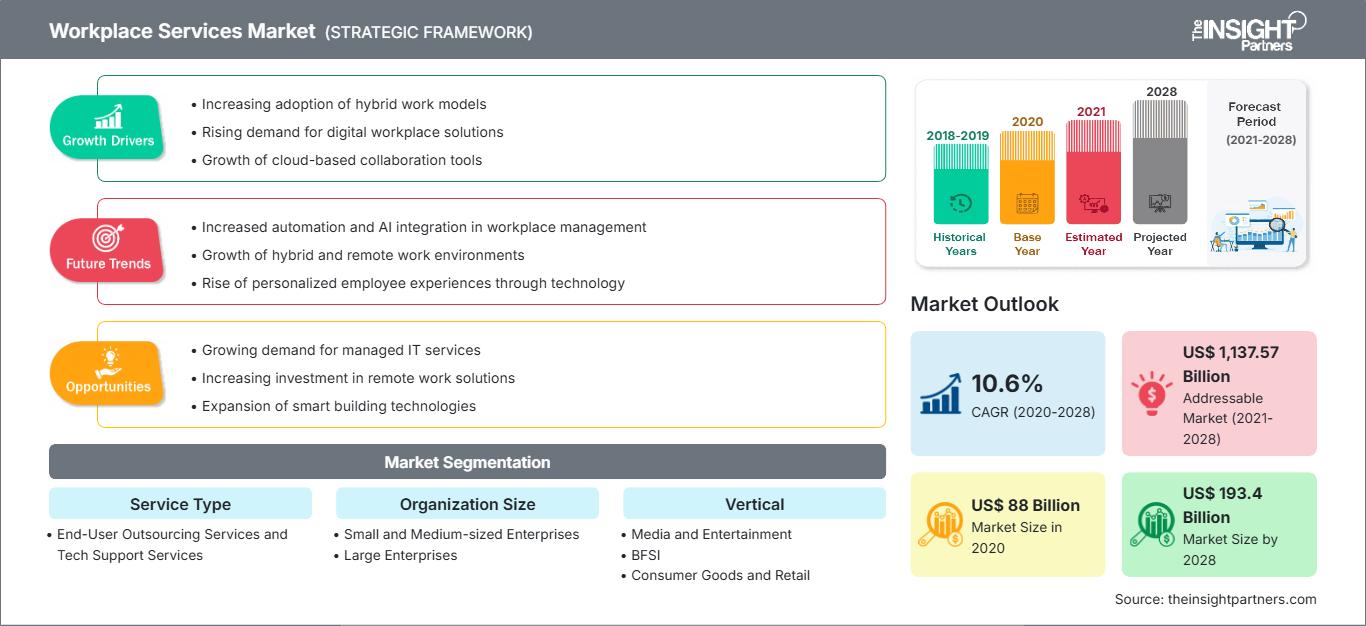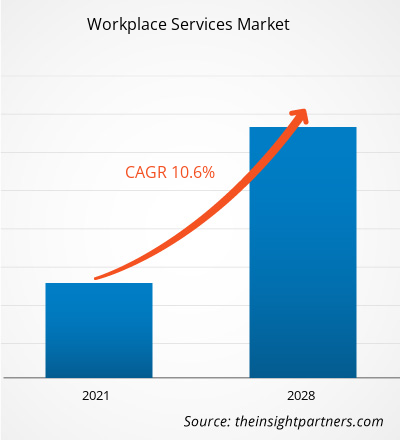Der Markt für Arbeitsplatzservices wurde im Jahr 2020 auf 88,0 Milliarden US-Dollar geschätzt und soll bis 2028 193,4 Milliarden US-Dollar erreichen; von 2021 bis 2028 wird ein CAGR von 10,6 % erwartet.
Technologie bietet Unternehmen zahlreiche Vorteile. Ein exponentielles Wachstum bei Anwendungen, Geräten und Netzwerken wirkt sich positiv auf die Arbeitskultur aus. Sicherere Arbeitsumgebungen, hybride Arbeitsplätze, zusätzliche Cybersicherheit und eine global verteilte Belegschaft sind einige der Aspekte, die zum Konzept des modernen Arbeitsplatzes beitragen und somit das Wachstum von Arbeitsplatzservices beeinflussen. Daher fragen die gut etablierte IT-Infrastruktur sowie kleine, mittlere und große Unternehmen in allen Regionen Arbeitsplatzservices nach. Es wird erwartet, dass Unternehmen jeder Größe in innovative und neueste Technologien investieren, um ihr Geschäft effektiv zu betreiben. Unternehmen auf der ganzen Welt nutzen Arbeitsplatzservices, um ihr Geschäft anzukurbeln und ihre Geschäftsanstrengungen zu optimieren, um den geringstmöglichen Investitionsbedarf in verschiedenen Prozessen sicherzustellen.
Passen Sie diesen Bericht Ihren Anforderungen an
Sie erhalten kostenlos Anpassungen an jedem Bericht, einschließlich Teilen dieses Berichts oder einer Analyse auf Länderebene, eines Excel-Datenpakets sowie tolle Angebote und Rabatte für Start-ups und Universitäten.
Markt für Arbeitsplatzdienstleistungen: Strategische Einblicke

-
Holen Sie sich die wichtigsten Markttrends aus diesem Bericht.Dieses KOSTENLOSE Beispiel umfasst Datenanalysen, die von Markttrends bis hin zu Schätzungen und Prognosen reichen.
Die COVID-19-Pandemie hat zahlreiche Branchen erschüttert. Die rasant zunehmende Verbreitung des Virus veranlasste Regierungen weltweit, strenge Beschränkungen für die Bewegung von Fahrzeugen und Personen zu verhängen. Reiseverbote, Massen-Lockdowns und Betriebsschließungen beeinträchtigen die Pandemie die Wirtschaft und zahlreiche Branchen in verschiedenen Ländern. Die Anbieter von Arbeitsplatzdienstleistungen setzten ihre Aktivitäten aus der Ferne fort, um ihren Endkunden optimale Dienstleistungen zu bieten. Selbst während der Pandemie waren mehrere Marktteilnehmer weiterhin gut aufgestellt, um ihre Endkunden durch die Krise zu begleiten. Die COVID-19-Pandemie hat Unternehmen dazu veranlasst, ihre digitale Transformation voranzutreiben, was zur Beseitigung traditioneller Fortschrittshemmnisse führt. Unternehmen unterstützen ihre Endbenutzer weiterhin durch virtuelle Interaktion, Modernisierung und Migration von Anwendungen in die Cloud, die Ermöglichung von Remote-Arbeit und die Konzentration auf Cybersicherheit und IT-Ausfallsicherheit.
Markteinblicke in Workplace Services: Wachsende Bedeutung von Enterprise Mobility
Enterprise Mobility ist ein weit gefasster Begriff, der mobile Virtualisierung, Mobile Device Management und mobile Virtualisierung umfasst, die die Produktivität steigern, Services verbessern und das Benutzererlebnis optimieren. Die Enterprise-Mobility-Branche hat sich enorm entwickelt, da Unternehmen nach Services suchen, die alle Aspekte der mobilen Sicherheit abdecken, von Geräten und Software bis hin zum Datenschutz. Heutzutage ist die Nachfrage nach Enterprise Mobility in der Belegschaft auf einem Höchststand, insbesondere aufgrund des COVID-19-Ausbruchs, der das Konzept der Remote-Arbeit verstärkt. Die zunehmende Nutzung von Enterprise Mobility ermöglicht es Unternehmen, Daten von Geräten aus der Ferne zu steuern, zu aktualisieren und sogar zu löschen. Enterprise Mobility ermöglicht Mitarbeitern den sicheren Zugriff auf vertrauliche Unternehmensdaten, ohne Anwendungen/Software auf ihren Geräten installieren zu müssen. All diese Vorteile treiben die Nachfrage nach Arbeitsplatzdiensten in allen Branchen weltweit an.
Markteinblicke nach Servicetypen
Nach Servicetypen dominiert das Segment der Endbenutzer-Outsourcing-Dienste den Markt. Die Endbenutzer-Outsourcing-Dienste umfassen Netzwerkverwaltungsdienste, Remote-Support-Dienste, Standard- und Ad-hoc-Berichterstellung und -Dokumentation, gehostete virtuelle Desktopdienste, Softwaredienste, Mobilitäts- und Sicherheitsdienste.
Markteinblicke nach Unternehmensgröße
Nach Unternehmensgröße dominiert das Segment der Großunternehmen den Markt. Große Unternehmen auf der ganzen Welt konzentrieren sich auf Kostenoptimierung und Steigerung der Gesamtproduktivität. Der zunehmende Bedarf an einer integrierten Plattform für die riesigen Datenmengen aus verschiedenen Branchen und für wichtige Entscheidungen in Bezug auf Aspekte wie Strategie, Marketing und Teammanagement treibt die Nachfrage nach Arbeitsplatzdiensten bei großen Unternehmen an.
Brancheneinblicke
Nach Branchen hält das Segment Telekommunikation – IT und ITES weiterhin einen bedeutenden Marktanteil. Die wachsenden Branchen Telekommunikation, IT und ITES haben eine hohe Nachfrage nach Arbeitsplatzdiensten, um durch Mobilität, Zusammenarbeit und Benutzerunterstützung einen durchgängigen Ansatz in Arbeitsabläufen zu verfolgen und gleichzeitig die betrieblichen IT-Kosten zu senken. Die Dienste erfüllen die modernen Anforderungen an digital optimierte Arbeitsplätze in diesem Sektor.
Die Akteure auf dem Markt für Arbeitsplatzdienste konzentrieren sich auf Strategien wie Partnerschaften, Fusionen, Übernahmen und Marktinitiativen, um ihre Position auf dem Markt zu behaupten. Im Folgenden sind einige Entwicklungen der wichtigsten Akteure aufgeführt:
Im Februar 2021 gab die Unisys Corporation ihre Partnerschaft mit Lenovo bekannt. Im Rahmen dieser Partnerschaft wird die Unisys Corporation die Internet of Think (IoT)-Lösungen von Lenovo mit den Digital Workplace Services der Unisys Corporation unterstützen.
Im Juni 2020 gab Wipro seine Partnerschaft mit Citrix und Microsoft bekannt. Im Rahmen dieser Partnerschaft würde Wipro die von Citrix und Microsoft angebotenen Host-Dienste für die schnelle und sichere Bereitstellung zuverlässiger digitaler Arbeitsplätze (einschließlich Anwendungspakete) nutzen.
Im Dezember 2020 gab DXC Technology seine Partnerschaft mit Microsoft bekannt. Im Rahmen der Partnerschaft würde DXC Technology die Service-Suite von Microsoft, wie Dynamics 365 und Power Platform sowie Microsoft 365 und Teams, nutzen, um die modernen Arbeitsplatzdienste und -lösungen von DXC Technology zu verbessern und zu erweitern.
Markt für Arbeitsplatzdienstleistungen
Die Analysten von The Insight Partners haben die regionalen Trends und Faktoren, die den Markt für Arbeitsplatzdienstleistungen im Prognosezeitraum beeinflussen, ausführlich erläutert. In diesem Abschnitt werden auch die Marktsegmente und die geografische Lage in Nordamerika, Europa, dem asiatisch-pazifischen Raum, dem Nahen Osten und Afrika sowie Süd- und Mittelamerika erörtert.Umfang des Marktberichts zu Arbeitsplatzdienstleistungen
| Berichtsattribut | Einzelheiten |
|---|---|
| Marktgröße in 2020 | US$ 88 Billion |
| Marktgröße nach 2028 | US$ 193.4 Billion |
| Globale CAGR (2020 - 2028) | 10.6% |
| Historische Daten | 2018-2019 |
| Prognosezeitraum | 2021-2028 |
| Abgedeckte Segmente |
By Servicetyp
|
| Abgedeckte Regionen und Länder |
Nordamerika
|
| Marktführer und wichtige Unternehmensprofile |
|
Dichte der Marktteilnehmer im Bereich Arbeitsplatzdienstleistungen: Verständnis ihrer Auswirkungen auf die Geschäftsdynamik
Der Markt für Arbeitsplatzdienstleistungen wächst rasant. Dies wird durch die steigende Nachfrage der Endnutzer aufgrund veränderter Verbraucherpräferenzen, technologischer Fortschritte und eines stärkeren Bewusstseins für die Produktvorteile vorangetrieben. Mit der steigenden Nachfrage erweitern Unternehmen ihr Angebot, entwickeln Innovationen, um den Bedürfnissen der Verbraucher gerecht zu werden, und nutzen neue Trends, was das Marktwachstum weiter ankurbelt.

- Holen Sie sich die Markt für Arbeitsplatzdienstleistungen Übersicht der wichtigsten Akteure
- Endbenutzer-Outsourcing-Services
- Technischer Support
Nach Unternehmensgröße
- KMU
- Großunternehmen
Nach Branche
- Telekommunikation – IT und ITES
- BFSI
- Fertigung
- Konsumgüter und Einzelhandel
- Gesundheitswesen und Biowissenschaften
- Regierung und öffentlicher Sektor
- Energie und Versorgung
- Medien und Unterhaltung
- Bildung
- Andere
Nach Geografie
- Norden Amerika
- USA
- Kanada
- Mexiko
- Europa
- Frankreich
- Deutschland
- Italien
- Großbritannien
- Russland
- Übriges Europa
- Asien-Pazifik (APAC)
- China
- Indien
- Süden Korea
- Japan
- Australien
- Rest von APAC
- Naher Osten und Asien Afrika (MEA)
- Südafrika
- Saudi-Arabien
- VAE
- Rest von MEA
- Südamerika (SAM)
- Brasilien
- Argentinien
- Rest von SAM
Unternehmensprofile
- DXC Technologie
- Wipro
- IBM Corporation
- HCL Technologies
- TCS
- NTT Data
- CompuCom Systems Inc.
- ATOS
- UNISYS
- Fujitsu Ltd.
- Cognizant
- Accenture PLC
- Historische Analyse (2 Jahre), Basisjahr, Prognose (7 Jahre) mit CAGR
- PEST- und SWOT-Analyse
- Marktgröße Wert/Volumen – Global, Regional, Land
- Branchen- und Wettbewerbslandschaft
- Excel-Datensatz
Aktuelle Berichte
Erfahrungsberichte
Grund zum Kauf
- Fundierte Entscheidungsfindung
- Marktdynamik verstehen
- Wettbewerbsanalyse
- Kundeneinblicke
- Marktprognosen
- Risikominimierung
- Strategische Planung
- Investitionsbegründung
- Identifizierung neuer Märkte
- Verbesserung von Marketingstrategien
- Steigerung der Betriebseffizienz
- Anpassung an regulatorische Trends






















 Kostenlose Probe anfordern für - Markt für Arbeitsplatzdienstleistungen
Kostenlose Probe anfordern für - Markt für Arbeitsplatzdienstleistungen